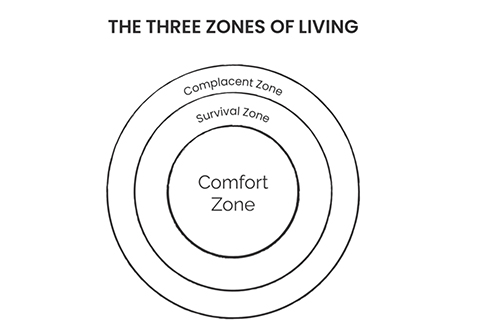We all live our lives from within one of the Three Zones of Living: the Complacent Zone, the Survival Zone, and the Comfort Zone. Typically we bounce in and out of each of these zones throughout our life. The zone where you spend most of your time determines the quality of your choices and therefore the quality of your life.
For example, your enjoyment of life is impacted greatly by which of these zones you most consistently make your home. Happiness studies show that once our basic survival needs are met, more possessions don’t always translate into more happiness. In fact, the pressure of working more and harder in order to attain bigger lives compounds our level of stress, causing us to feel increasingly unhappy and unfulfilled. When we use effort and hard work to push ourselves to grow, we are in danger of diminishing the true quality of our lives even as we achieve more.
Understanding the Three Zones of Living, knowing where you are at any given moment, and continually moving into the zone that fosters inner peace and connection is the most effective way that I know to improve the quality of your life and create experiences that are enjoyable and fulfilling.
Complacent Zone
This zone is characterized by a false sense of contentment and satisfaction, which is frequently used to conceal fear, self-doubt, and limiting beliefs. People in this zone may be dissatisfied with life, critical of themselves, and pessimistic about the future. They may experience negative emotions such as worry, blame, resentment, depression, and anxiety on a daily basis.
The Complacent Zone can lead to a lack of action, passion, and genuine engagement with life. People may feel stuck, lost, and hopeless if they believe they are in a state of stagnation.
It is important to acknowledge these feelings and to work towards breaking out of the Complacent Zone by recognizing and confronting the limiting beliefs that keep us stuck and moving towards growth and self-discovery.
Survival Zone
I’ve witnessed firsthand the consequences of living in the Survival Zone. This zone is fueled by high effort, and those who are overachievers and routinely push themselves outside of their comfort zone will most likely spend the majority of their time here. Due to the constant comparison and competition, this zone can also foster feelings of envy, judgment, and resentment. Everything in the Survival Zone is constantly changing, from one’s beliefs about what is possible to their fears and doubts, resulting in inconsistent results and unexpected setbacks.
I’ve also seen how this zone can lead to exhaustion, whether from mediocre results despite intense effort or from the constant effort required to maintain highly successful results.
After reflecting on the life of my grandfather, who lived and worked in the Survival Zone, I was inspired to write about it. He was a successful salesman in the Pittsburgh steel industry, dedicated to his job and the American Dream. He relocated his family several times and worked long hours, frequently traveling for work on weekends. The grind of this life, however, eventually caught up with him, and he became an alcoholic who struggled with stress. Unfortunately, his hard work and dedication did not pay off in the end, as he died of cancer shortly after retiring.
My grandfather’s life was a shining example of the dangers of living in the Survival Zone, and I see it all around me in American offices full of stressed, overworked, and burned-out employees. The evidence of this zone can be found everywhere, from the stacks of documents on executives’ desks to the tired eyes of the employees I pass. Many people live this way, just trying to make ends meet and chasing success at the expense of their well-being.
Comfort Zone
The Comfort Zone is a safe space where you can express yourself without fear of being judged. It’s full of things that make you feel at ease and natural, and it gives you power during stressful times. When you’re in your Comfort Zone, your stress center (the amygdala) is inactive, and you’re at peace, which allows your body to heal and your brain to become more creative. The HeartMath Institute’s scientific research has shown that when you feel safe, your heart rate goes into coherence, resulting in more efficient organ function and faster healing.
I enjoy seeing my children in their Comfort Zone. They move with grace, joy, and a sense of boundless possibilities. And, like children, the Comfort Zone is not a static environment. Because we are learning creatures who seek new experiences and push the limits of our abilities, it can always expand and become more. My daughter’s Comfort Zone expanded as she became more at ease at the park, progressing from clinging to me to making friends and playing independently.
Adults frequently resist expanding their Comfort Zone for fear of becoming stuck in it. However, living from the Comfort Zone implies that we choose paths that make us feel safe, comfortable, and supported rather than paths that cause anxiety and fear. This is the key to my success in growing the Power of Positivity community to millions of people. People frequently ask me how I did it, but it’s not much different from other business books and programs – it’s simply a matter of being aware of how I feel and making choices that align with my comfort and safety.
The Takeaway: You Can Use Your Mind to Transform Your Day From Bad to Good
Sure, everyone has an occasional “bad day,” especially when they wake up to the rush of a morning commute, kids dragging their feet, and deadlines looming. I have those days, too.
But to ignore the negativity instead of addressing it only empowers it to destroy your entire day.
So learn your “zone” and take steps to find your comfort zone. Take the time each day to acknowledge any negative feelings and transform your negativity to positivity. Understand and accept that you deserve self-love.
You will shine with positivity after you give yourself permission to live a joyful life.






